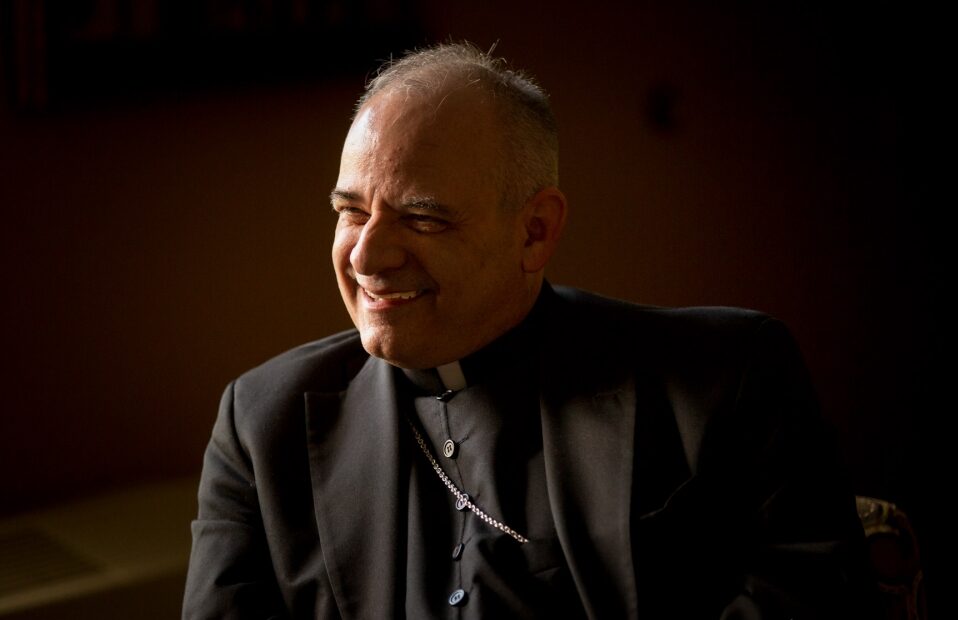As hospital chaplains, seminarians bring Christ to the people

Seminarians put classroom experience to use in summer chaplaincy program

Nobody asked for a chaplain. Nobody — except a day-old baby — was even in the NICU room. But seminarian Ben Wolf entered. Gently, he placed his hand on the baby, closed his eyes and prayed.
While the infant will never remember the gesture, the child needed Wolf’s presence.
“Everybody has spiritual needs,” seminarian John Paul Angeli reminded three doctors after a nurse mentioned that one of her patients said he didn’t have spiritual needs.
Angeli and Wolf, both incoming second-year theology students at Kenrick-Glennon Seminary, have served as chaplains at Mercy Hospital St. Louis since June. Under the purview of Sister Janet Crane, SSND, who has taught seminarians how to be hospital chaplains for the past eight years, Wolf and Angeli are putting what they have learned in the classroom into practice.
Practical Theology
Sister Janet has been a hospital chaplain for more than three decades. She seeks to help the seminarians develop their pastoral skills throughout the summer program.
“My goal is for them to experience as much pastoral work, pastoral practice, pastoral ministry as they possibly can,” she said. “This will help them integrate their theology in the practical world. After this, they will never look at pastoral ministry the same.”

The beginning was not easy. Angeli struggled with empathy even though he had a class in seminary on the virtue. Wolf was timid to walk into rooms. But with a little pushing and nudging, Sister Jane stretched their hearts.
“This is where the rubber hits the road,” Wolf said. “We are to encounter and bring Christ to the people. At the seminary, we get an understanding of what the Christ portion is. Now, we’re understanding the people portion and how to be present to them.”
Continual training is a cornerstone of the program. The seminarians meet with Sister Janet twice a day to discuss their encounters and how they can improve their ministry. At first, the seminarians were unsure of how to describe their experiences. But with Sister Janet’s prodding, they opened up.
“The transformation I’ve seen in these guys is incredible,” Sister Janet said. “They came with a set idea, not fully knowing what the summer was going to be like. These two fellows were open to those experiences and have grown and opened up in such a short amount of time.”
That transformation takes place well beyond the comforts of the chaplain’s meeting room. It happens in the Intensive Care Unit or the emergency waiting room, where the seminarians encounter people at some of their lowest moments.
Experiencing humanity’s depth
On one of his first days ministering in the NICU, Wolf witnessed the miracle of birth with one infant and death with another infant.
“The juxtaposition of rejoicing in life beginning, but then the sadness of the loss of a baby in the evening hits so deeply and I’m still processing it,” Wolf said. “I was able to just be present in both of those situations which was deeply moving.”
The seminarians build trust and goodwill with patients by their presence in the patients’ rooms. Angeli had been making daily visits to a patient in the ICU. A couple of days into the man’s hospital stay, he became erratic, trying to break out of the hospital. Hearing the commotion, Angeli rushed into his room. The doctors were struggling to communicate with him. Angeli, however, spoke calmly and carefully, successfully asking the man to stay in his room for a little longer.
Encounters like these have helped Angeli recognize the importance of learning to be present, and it has helped him hone his relational ministry skills.
“As a priest, you’re going to be with people, and you need to learn how to be present with people freely,” Angeli said. “A priest is expected to be with you in those difficult times. The priest should be a safe person that you can share the hard parts and struggles of your life with. If I’m not ready for that or I feel uncomfortable with people who are struggling, it’s going to be very hard to live a fruitful priesthood.”
Stretching their Hearts

The seminarians have also ministered to patients, family members, doctors and nurses throughout the program. Three times in one day, Angeli was pulled into a dying patient’s room to visit with her children and grandchildren.
“There was a large Catholic family putting this grandmother on hospice, and new family members just kept showing up. They wanted a priest to be there. While I’m not a priest, they felt comfort in having a collar there,” Angeli said. “It was an honor to visit and minister to that grieving family.”
Whenever Wolf walks past doctors or nurses, he always gives them a friendly smile or wave. If they start a conversation, he always accepts, listening to their stories and concerns.
“We’re here to be chaplains to the nurses and doctors as well,” Wolf said. “There have been so many doctors and nurses that I simply ask ‘How are you doing?’ And they’re like, ‘Oh, it’s been a long day,’ and that just opens the door to a very deep and beautiful conversation.”
Every day, the seminarians have a new experience. Some are beautiful, others are painful, but each shows them a new part of humanity and God’s love. And while the seminarians have impacted the lives of countless patients and family members, those same patients have stretched the seminarians in new ways.
“This program is stretching me, and I think that is the best part,” Wolf said. “I’m not adequate to be able to fully do everything, because I am still new to being a chaplain. But when I get called to go into a room, I just give what I have. That’s all I can do. I’ve had to put a lot of faith and trust in giving what I have. It has been so rewarding because I’m with real people and I get to experience the depth of humanity.”
Nurse Paul Nganga helped Theology II seminarian John Paul Angeli put on contact precaution gloves and a gown before speaking with a patient July 11 at Mercy Hospital St. Louis. … As hospital chaplains, seminarians bring Christ to the people
Subscribe to Read All St. Louis Review Stories
All readers receive 5 stories to read free per month. After that, readers will need to be logged in.
If you are currently receive the St. Louis Review at your home or office, please send your name and address (and subscriber id if you know it) to subscriptions@stlouisreview.com to get your login information.
If you are not currently a subscriber to the St. Louis Review, please contact subscriptions@stlouisreview.com for information on how to subscribe.






